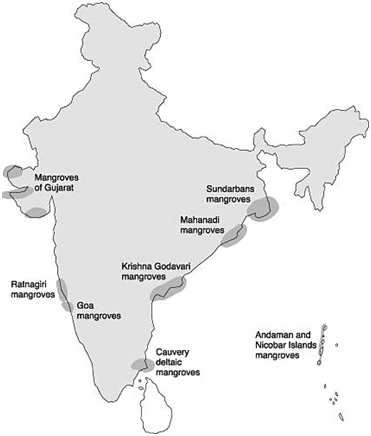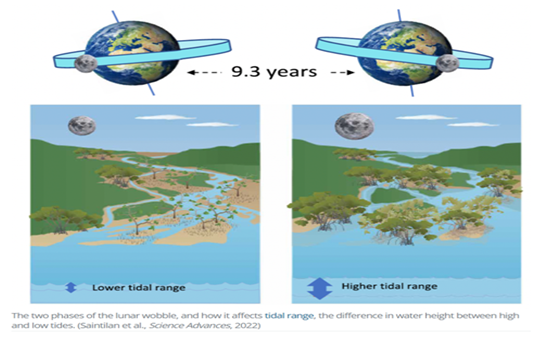

Context
In a new study published in Science Advances, scientists have found that the oscillation of the moon’s orbit or ‘moon wobble’ has a significant impact on the mangrove canopy cover of the world.
About
What are mangroves?
- Mangroves are coastal trees that offer habitat for fish as well as protection from erosion.
- However, in some areas, they are threatened by a variety of factors, notably coastal development, pollution, and land removal for agriculture.

About
The Moon Wobble:
- Unlike the Chandler Wobble, which describes the movements in the Earth’s orbit, a moon wobble describes the fluctuations in the moon’s orbit, with wobbles occurring as a result of changes in the moon’s elliptical orbit and their resulting gravitational pull on the Earth.
- Such changes are part of the moon’s natural cycle, in which its 18.6 year span is split down the middle, with half of its cycle seeing more suppressed daily tide levels and the other half amplifying tide levels.
- It is a regular oscillation that humans have known about for centuries, and it is one of many factors that can either exacerbate rising sea levels or counteract them, alongside other variables like weather and geography.
|
Earth’s wobble is a fluctuation in its gravitational pull that influences tidal activity. |
Key highlights of the Study:
- The moon plays an important role when it comes to regulating the Earth’s oceans.
- Its gravitational pull forms tides that maintain the health of the oceans, coastal areas and biodiversity.
- The new study has found that these long-phase tidal cycles play an important role in the regulation of tidal wetland ecosystems— such as the growth of mangrove forests.
- When the lunar wobble is in its minimum phase, the researchers figured that mangrove ecosystems would be sucked dry, experiencing fewer days where their roots were saturated and greater water stress, leading to thinner canopy
- At its maximum, the lunar wobble might thrust tides higher, boosting mangrove growth.

- The synchronicity between the lunar wobble and mangrove canopy cover stood out against a backdrop of steady climate change, whereby higher air temperatures, sea levels, and CO2 levels are associated with mangrove expansion and canopy thickening.
- The new research has also discovered these factors of lunar cycles and daily tides also interact with other climatic events such as the El Niño-Southern Oscillation, which influences alternating periods of heavy rainfall and prolonged droughts in eastern Australia and the western coasts of North and South America.
Impacts of Moon’s effects on Mangroves
|
Positive impacts |
Negative impacts |
|
|


